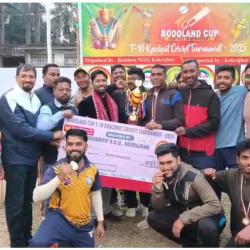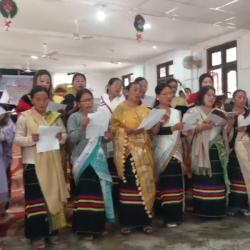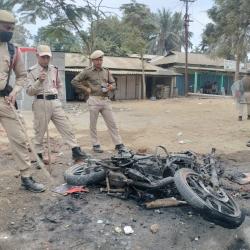With increasing possibility of Kaziranga National Park being inundated by the raging Brahmaputra River, the Centre for Wildlife Rehabilitation and Conservation (CWRC) -- an IFAW-WTI run wildlife welfare centre -- has started pre-flood awareness campaign for the safety of wildlife in the fringe villages of this world heritage site.
With support of Kaziranga Forest Authority, two awareness meetings for residents of six villages in the fringe areas have already been held in Central and Eastern Range of the park. More such meetings for wildlife protection during floods will be held to cover the entire Kaziranga –Karbi Anglong landscape.
Previously during floods, the wildlife of the park moved towards the highland and hill ranges of Karbi Anglong crossing the NH-37. This national highway has become a death trap for many animals and therefore extra protection measures are needed for animals when they cross this road. During these years, a large number of hog deer succumbed to road hits during the floods.
Moreover, to mitigate the human–animal conflict during this crisis, the IFAW-WTI team has formulated a work plan for wildlife safety following the awareness meetings held in the fringe villages of Kaziranga and those in the foothills of Karbi Anglong. Conservationists, panchayats, village headmen, local NGOs, civil and forest authorities attended these meetings and sensitised villagers on how to save wildlife.
During the course of these meetings, CWRC’s animal welfare experts highlighted the issue of “unnecessary rescue” of wildlife that causes displacement and sometimes leads to animal mortality, especially in deer species. Through audio-visual presentation and short videos, the participants were informed about flood rescue and guidelines on dos and don’ts were also shared.
CWRC designed informative bill-boards and leaflets in Assamese and handed it over to the village authorities to display at strategic locations for public awareness during the floods. Every banner has emergency contact numbers of CWRC and Kaziranga Control Room for immediate rescue. Two contact numbers of Kaziranga Control Room (03776-268007) and CWRC (03776-269563) would be operational 24*7.
Mukul Tamuli, Range Officer, Central Range, Kaziranga, said at the awareness meeting, “During flood days we have to work together for wildlife safety in Kaziranga. For any wildlife emergency, forest authorities are ready to work with the community like previous years. We also urge the villagers to keep a close eye on the movement of poachers during flood and intimate the forest authorities.” The Mobile Veterinary Service (MVS) unit of CWRC that has a team of veterinarians, animal keepers, biologists and other conservationists who would be ready to attend to any wildlife emergency.
As we see every year, Brahmaputra inundates the Kaziranga National Park and animals start moving towards Karbi Anglong foot hills where the threat of poaching is considerably high. Jagat Bahadur Chetri, renowned social worker from Tamuli Pathar village near Kaziranga, urged the participants not to catch deer which stray out of the park. He asked villagers to inform the Kaziranga Control room or CWRC if any wild animal needs to be rescued.
CWRC also trained a group of boys and girls of the fringe villages of Kaziranga on wild-rescue as part of the pre-flood awareness campaign.
“In the first awareness meeting, we asked the villagers whether they need any kind of help from CWRC. Few boys said that they want to know about rescue in detail, especially about snakes. A lot of snake related cases are reported from the region during floods and they wanted to know how to identify whether the snake is venomous or not. Keeping that in mind, we organised an orientation programme at the centre with 11 (8 boys and 3 girls),” said Dr Rathin Barman, Deputy Director, WTI.
During these awareness meetings, the IFAW-WTI team shared their experiences and gave suggestions on rescue of wild animals. Apart from the CWRC team, Uttam Saikia, eminent conservationist and honorary wildlife warden, and “Aranyak” team also participated in the workshop and gave valuable suggestions.
Mamoni Hazarika, Head Mistress, Dhansirimukh Janajatiya High School, one of the awareness campaign venue stressed that school children should not attack birds and deer with catapult during floods and even otherwise. This school is in a very sensitive area called Bohikhowa under eastern range of the park.
Moreover, the animal cages are ready for any kind of rescue operation at CWRC. The animal keepers of the centre are prepared to tackle any kind of wildlife emergencies. Till now, no rescue call has been received but forest guards are ensuring that drivers are not over speeding with the Time Card facility.
During the 2014 floods, the four MVS units of CWRC rescued 33 wild animals that had strayed out of Kaziranga in search of a safer location.
- 7815 reads










Add new comment